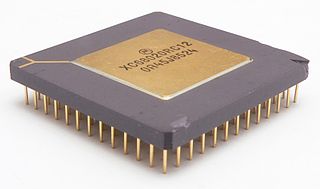
The Motorola 68020 is a 32-bit microprocessor from Motorola, released in 1984. A lower-cost version was also made available, known as the 68EC020. In keeping with naming practices common to Motorola designs, the 68020 is usually referred to as the "020", pronounced "oh-two-oh" or "oh-twenty".

Lisa is a desktop computer developed by Apple, produced from January 19, 1983 to August 1, 1986, and succeeded by Macintosh. It is generally considered the first mass-market personal computer operable through a graphical user interface (GUI). In 1983, a machine like the Lisa was still so expensive that it was primarily marketed to individual and small and medium-sized businesses as a groundbreaking new alternative to much bigger and more expensive mainframes or minicomputers such as from IBM, that either require additional, expensive consultancy from the supplier, hiring specially trained personnel, or at least, a much steeper learning curve to maintain and operate. Earlier GUI-controlled personal computers were not mass-marketed; for example, Xerox PARC manufactured its Alto workstation only for Xerox and select partners from the early to mid-1970s.
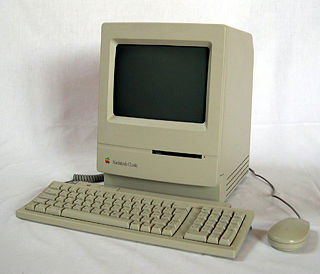
The Macintosh Classic is a personal computer designed, manufactured and sold by Apple Computer from October 1990 to September 1992. It was the first Macintosh to sell for less than US$1,000.

An industrial robot is a robot system used for manufacturing. Industrial robots are automated, programmable and capable of movement on three or more axes.

VMEbus is a computer bus standard physically based on Eurocard sizes.

The Macintosh IIfx is a personal computer designed, manufactured and sold by Apple Computer from March 1990 to April 1992. At introduction it cost from US$9,000 to US$12,000, depending on configuration, and it was the fastest Macintosh available at the time.

AppleWorks was an integrated office suite containing a word processor, database, and spreadsheet. It was developed by Rupert Lissner for Apple Computer, originally for the Apple II and launched in 1984. Many enhancements for AppleWorks were created, the most popular being the TimeOut series from Beagle Bros which extended the life of the Apple II version of AppleWorks. Appleworks was later reworked for the Macintosh platform.
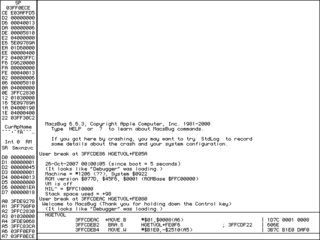
MacsBug is a low-level debugger for the classic Mac OS operating system. MacsBug is an acronym for Motorola Advanced Computer Systems Debugger, as opposed to Macintosh debugger. The original version was developed by Motorola as a general debugger for its 68000 systems. — it was ported to the Mac as a programmer's tool early in the project's development.

The Yaskawa Electric Corporation is a Japanese manufacturer of servos, motion controllers, AC motor drives, switches and industrial robots. Their Motoman robots are heavy duty industrial robots used in welding, packaging, assembly, coating, cutting, material handling and general automation.
PlainTalk is the collective name for several speech synthesis (MacinTalk) and speech recognition technologies developed by Apple Inc. In 1990, Apple invested a lot of work and money in speech recognition technology, hiring many researchers in the field. The result was "PlainTalk", released with the AV models in the Macintosh Quadra series from 1993. It was made a standard system component in System 7.1.2, and has since been shipped on all PowerPC and some 68k Macintoshes.

DECtape, originally called Microtape, is a magnetic tape data storage medium used with many Digital Equipment Corporation computers, including the PDP-6, PDP-8, LINC-8, PDP-9, PDP-10, PDP-11, PDP-12, and the PDP-15. On DEC's 32-bit systems, VAX/VMS support for it was implemented but did not become an official part of the product lineup.

vMac is a free and open-source Macintosh Plus emulator which is able to run versions of System 1.1 to 7.5.5. It is available for Windows, DOS, OS/2, Mac OS, NeXTSTEP, Linux, Unix, and other platforms. Although vMac has been abandoned, Mini vMac, an improved spinoff of vMac, is still actively developed.

Apple Inc. uses a large variety of typefaces in its marketing, operating systems, and industrial design with each product cycle. These change throughout the years with Apple's change of style in their products. This is evident in the design and marketing of the company. The current logo is a white apple with a bite out of it, which was first utilized in 2013.
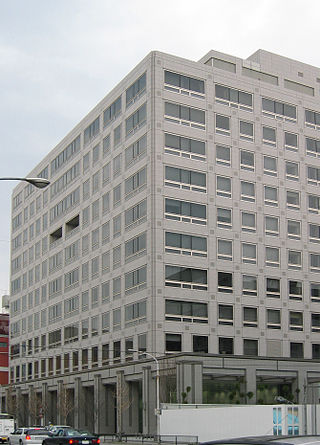
Omron Corporation, styled as OMRON, is a Japanese electronics company based in Kyoto, Japan. Omron was established by Kazuma Tateisi (立石一真) in 1933 and incorporated in 1948.

George Charles Devol Jr. was an American inventor, best known for creating Unimate, the first industrial robot. The National Inventors Hall of Fame says, "Devol's patent for the first digitally operated programmable robotic arm represents the foundation of the modern robotics industry."
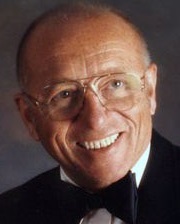
Joseph Frederick Engelberger was an American physicist, engineer and entrepreneur. Licensing the original patent awarded to inventor George Devol, Engelberger developed the first industrial robot in the United States, the Unimate, in the 1950s. Later, he worked as entrepreneur and vocal advocate of robotic technology beyond the manufacturing plant in a variety of fields, including service industries, health care, and space exploration.

Victor David Scheinman was an American pioneer in the field of robotics. He was born in Augusta, Georgia, where his father Léonard was stationed with the US Army. At the end of the war, the family moved to Brooklyn and his father returned to work as a professor of psychiatry. His mother taught at a Hebrew school.
MacWorks Plus was a complete implementation (port) of the Macintosh Plus 128K ROM on the Apple Lisa and Macintosh XL computer systems, and introduced in August 1988. It was developed for Sun Remarketing of Cache Valley, Utah, under license from Apple Inc., by a contract developer named Chuck Lukaszewski, who was responsible for versions up through 1.1(h), which supported up to Macintosh System 6.0.3. Dafax Processing Corp. with the assistance of Query Engineering, Inc. then further developed the environment to MacWorks Plus II, which continued Macintosh system support up to System 6.0.8 with the Basic version, and introduced a Pro version to extend support to the maximum possible for any 68000 processor: System 7.5.5. Prior to MacWorks Plus, the maximum system supported by its predecessor MacWorks XL was System 3.2.
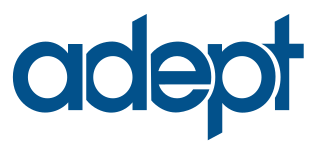
Omron Adept Technology, Inc. is a multinational corporation with headquarters in Pleasanton, California. The company focus on industrial automation and robotics, including software and vision guidance. Adept has offices throughout the United States as well as in Dortmund, Germany, Paris, France, and Singapore. Adept was acquired by Omron in October 2015.
RoboDK is an offline programming and simulation software for industrial robots. The simulation software allows you to program robots outside the production environment, eliminating production downtime caused by shop floor programming.





















